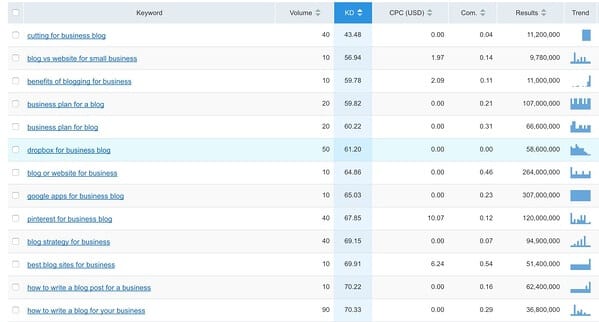Growing your business using your company website is a huge part of today’s world. For many buyers, if you don’t have a website your company might as well not exist.
Thankfully, by optimizing your website for search engines you can use the internet to present your product or service to potential buyers, whether they’re on the other side of the world or right down the street.
While website SEO requires a lot of knowledge and strategy to master, you can get started today on improving your company’s visibility with blogging for business. Consistent, strategic blogging is an SEO tactic that will send the signals Google is looking for to rank your site high in the search results.
Blogging for Business: The Basics
Blogging as a part of your online marketing strategy is often a part of Inbound Marketing, and posting blogs on your site regularly is an important aspect of growing your online presence.
Now, you just need to write a blog post and get it up on your site’s blog – but where do you begin?
The perfect blog post does more than just convey facts to your reader. A good blog will:
- Shows readers (and potential customers ) you’re knowledgeable and trustworthy
- Encourages readers to delve deeper into your site for information
- Moves visitors further down your sales funnel.
- However, just throwing up posts at random will not create engagement and drive sales on its own.
Growing your online presence with a consistent, engaging, and SEO optimized blogging takes time and thought.
Think of it as a skyscraper being built, step-by-step until it overshadows the competition and can’t be missed.

“Alright,” you say, “then how do I write a blog that will grow my business?”
Preparing Your Blog Post for Perfection
Before you even type the first word of your post, there are two things you need to do.
- Decide on your main keyword
- Identify the ideal customer (or persona) you are writing the post for
Keyword Research
Whether you decide on a keyword by doing basic keyword research yourself or let your marketing team put their experience and skills to work for you, the important thing is that you know what keyword you’ll be writing around for your post before you start writing.
Why do you need to decide on a main keyword for your Inbound blog post?
Well, it’s for the sake of that pesky little thing called SEO.
Search Engine Optimization is like building a roadmap for search engines (primarily Google) to read, and optimizing your blog post for a specific keyword helps search engines take users from their search query to your site using that roadmap.
 Looking at statistics like these help you find what keywords you should be ranking for.
Looking at statistics like these help you find what keywords you should be ranking for.
Choosing a keyword helps you optimize your blog post for both readers and search engines. Writing a blog post without choosing a keyword or doing SEO is kind of like building a fancy restaurant in the middle of the desert, and then being surprised when no one walks through the doors for dinner.
Identify Who You’re Writing For
Next, identify who you’ll be writing for. This part of the process is key to writing in a style and tone that connects to your ideal customer.
To quote many others, “if you try and appeal to everyone, you will appeal to no one.”A well-written post may not connect to everyone who reads it, but it will connect to the reader who will actually consider buying from you.
Putting Pen to Paper (Or Fingers to Keys)
Once you’ve identified your ideal customer and decided upon your main keyword, it’s time to come up with a title for your blog.
Make sure to include your keyword in the title (preferably towards the beginning) and make sure that the title is relevant and intriguing to your target buyer.
After you’ve found your title, you’re ready to start writing the blog copy.
Get creative with your blog post, share the knowledge you possess on your subject and provide your readers value that will give them a reason to come back for more.
Don’t forget to use your keyword throughout your copy, most importantly in the following areas:
- Sprinkled naturally throughout the body copy 6+ times (assuming an 800-word post)
- The first header in the blog (ideally placed after or around the second paragraph)
- The first and last paragraph of your blog
- Variations of your keyword are also important. For example, if your main keyword is “how to make an apple pie”, “pie ingredients” is also useful to include in the post.
Don’t Forget About Organization
As you’re translating the knowledge you have on your topic to words for others to benefit from, don’t forget to organize your copy in a way that is engaging and easy to read.
Always start with an introduction that lays out what will be covered in your post and creates curiosity about the topic – this should take up about 1/5th of your post.
Next, the main body of your post should make up roughly 3/5ths of your blog post.
The main body is what your readers are here for, so fill it with relevant and specific information on the topic you’ve introduced (don’t forget the persona you’re writing for!).
Keep the main body of your copy from being a daunting wall of text by frequently placing paragraph breaks and subheadings when appropriate.

This is basic writing structure and can be expanded on depending on the needs of the content. However, at the very least be sure to make this the organizational structure upon which you hang your article.
Finally, wrap your perfect inbound blog post up with a concluding paragraph or two that summarizes the main body of your post and encourages readers to take action, whether that action is in the form of downloading an ebook or filling out a contact form.
Yes, I know this organization seems very basic and obvious, but you’d be surprised at how many times I’ve seen people completely ignore opening with an introduction and closing with a conclusion – enough times to feel that I need to include those instructions here!
Bonus: If you’re looking to grow your Inbound Marketing Skills, make sure to read this article on Email Marketing Success, the inbound way.
Whamo! It’s the Perfect Inbound Blog Post
Nice work, you’ve written the perfect inbound blog post!
Now comes the hard part – doing this on a regular basis.
Building that skyscraper to outshine your competitors takes quality posts, time, and consistency, but all of these are achievable goals.
If you are persistent in learning about Inbound Marketing for your business and continue to write content that is engaging and informative, you’ll be well on your way to growing your business with a dominating online presence.
